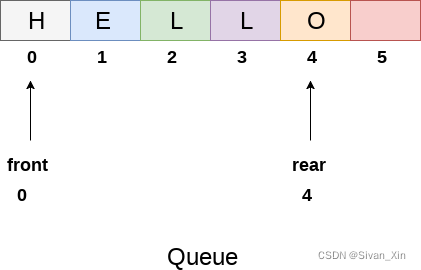文章目录
数据结构所必备的知识,适合入门学习,作者也是一边学习一边分享,
如果觉得写的还不错的话,欢迎点一个收藏再走哦~~~
,后续会出更多有关于数据结构与算法的文章,也请大家多多关注!

队列
队列最显著的特点就是
先进先出
。
-
思路:
使用
front
和
rear
两个指针,front永远指向队列头的
前一个元素
,rear指向队列尾。
入队:rear后移,给数组赋值。
出队:front后移,取出该数组。
arr[front+1]
为队列头部。

代码实现
/**
* arr[] 用数组来模拟队列。
* maxSize 表示数组最大容量。
* front 用于指向队列头。
* rear 用于指向队列尾。
*/
public class ArrayQueue {
private int []arr;
private int maxSize;
private int front;
private int rear;
public ArrayQueue(int maxSize){
this.maxSize=maxSize;
arr = new int[maxSize];
front=-1;
rear=-1;
}
// 判断队列是否满
public boolean isFull(){
return rear==maxSize-1;
}
//判断队列是否空
public boolean isEmpty(){
return rear==front;
}
//添加数据到队列。
public void addQueue(int date){
if(isFull()){
System.out.println("False");
return ;
}
rear++;
arr[rear]=date;
}
//出队列
public int getQueue(){
if(isEmpty()){
//由于返回int所以这里利用抛出异常。
throw new RuntimeException("Error");
}
front++;
return arr[front];
}
// 显示队列的所有数据
public void showQueue() {
if (isEmpty()) {
System.out.println("队列空的,没有数据~~");
return;
}
for (int i = 0; i < arr.length; i++) {
System.out.printf("arr[%d]=%d\n", i, arr[i]);
}
}
}
环形队列
这里可以直接参考之前写的一篇文章,里面讲的非常详细!
链接:
环形队列详解
链表
单链表不需要连续的存储空间,所以在删除和增加结点时不需要像顺序表一样需要移动全部的元素,提高运行效率。
单链表

add/addByOrder
- (add)设置辅助变量
- 循环遍历链表,找到链表的最后一个结点。
-
temp.next=node
- (addByOrder)设置辅助变量
-
循环遍历链表,
找到插入点的前一个位置
。(考虑:如果序号相同,无法插入。) -
node.next=temp.next
和
temp.next=node
(注意顺序,要让新增节点先指向。)
delete/update
- (delete)设置辅助变量。
- 遍历链表,找到需要删除的结点的前一个结点。
-
temp.next=temp.next.next
- (update)设置辅助变量。
- 遍历链表,找到需要更改的结点。
-
temp.date=node.date
代码实现
class SingleList{
Node1 head=new Node1(0,0);
//增加链表到最后
public void add(Node1 node){
Node1 temp=head;
while(true){
if(temp.next==null){
break;
}
temp=temp.next;
}
temp.next=node;
}
//按序号增加链表
public void addByOrder(Node1 node){
Node1 temp=head;
while(true){
if(temp.next==null){
break;
}
if(temp.next.no>=node.no){
break;
}
temp=temp.next;
}
node.next=temp.next;
temp.next=node;
}
//删除指定结点
public void delNode(Node1 node){
Node1 temp=head;
while(true){
if(temp.next==node){
break;
}
temp=temp.next;
}
temp.next=temp.next.next;
}
//修改单链表的结点
public void update(Node1 node,int update){
Node1 temp=head;
while(true){
if(temp.no==node.no){
break;
}
temp=temp.next;
}
temp.date=update;
}
//打印单链表
public void list(){
Node1 temp=head.next;
if(head.next==null){
System.out.println("Empty!");
}
while(temp!=null){
System.out.println(temp.toString());
temp=temp.next;
}
}
}
//创建一个类,每个类的对象就是一个结点。
class Node1{
public int date;
public int no;
public Node1 next;
public Node1(int date, int no) {
this.date = date;
this.no = no;
}
@Override
public String toString() {
return "Node1{" +
"date=" + date +
", no=" + no +
'}';
}
}
双向链表
对于单向链表而言,只有一个查找方向,并且不能自我删除。
所以引入双向链表,与单向链表的主要不同点只是在于
pre指针的引入和删除操作
next:指向下一个结点。
pre:指向前一个结点。
- 操作思路:
- 遍历和修改:和单链表一样,遍历可以向前也可以向后查找。
-
添加(添加到最后):先找到最后的节点。
temp.next=newNode;
newNode.pre=temp;
2.1 添加(按序号添加):除了单链表的两个基础指向代码,还需要新增以下代码:
node.pre=temp;
node.next.pre=node;
-
删除:直接找到待删除节点(temp)。
(1)
temp.pre.next=temp.next;
//删除节点的前一个节点【指向】 删除节点的下一个节点。
(2)
注意!!
如果要删除的结点不是最后一个结点,那么执行(3)
(3)
temp.next.pre=temp.pre;
//删除节点的后一个节点向前【指向】删除节点的前一个节点。
代码实现
class DoubleLinkedlistDemo{
private Nodes head=new Nodes(0,0);
//默认加到链表最后。
public void add(Nodes node){
Nodes temp=head;
while(true){
if(temp.next==null){
break;
}
temp=temp.next;
}
temp.next=node;
node.pre=temp;
}
//按照no的顺序增加链表。
public void addByOrder(Nodes node){
Nodes temp=head;
boolean flag=false;
while(true){
if(temp.next==null){
flag=true;
break;
}
if(temp.next.no>=node.no){
break;
}
temp=temp.next;
}
if(flag){
add(node);
return;
}
//让添加进来的节点先指向。
//单链表指向。
node.next=temp.next;
temp.next=node;
//双向链表新增指向。
node.pre=temp;
node.next.pre=node;
}
//删除节点。(找到当前要删除的节点即可)
public void del(Nodes node){
Nodes temp=head;
if(head.next==null){
System.out.println("Empty!");
return ;
}
while(true){
if(temp== node){
break;
}
temp=temp.next;
}
//绕过当前结点,指向下一个结点。
temp.pre.next=temp.next;
if(temp.next!=null){
temp.next.pre=temp.pre;
}
}
//打印链表,同单链表一样
public void list(){
Nodes temp=head;
while(true) {
temp=temp.next;
System.out.println(temp);
if(temp.next==null){
break;
}
}
}
}
class Nodes{
public int no;
public int date;
public Nodes next;
public Nodes pre;
public Nodes(int no,int date){
this.no=no;
this.date=date;
}
@Override
public String toString() {
return "Nodes{" +
"no=" + no +
", date=" + date +
'}';
}
}
环形链表(Joseph Ring)
- 思路分析:
-
创建
first
指针,永远指向第一个元素,并且自成环状。 -
建立辅助指针
cur
,通过移动辅助指针来添加节点。
2.1 具体步骤为:辅助指针指向下一个节点、后移、再指向first。
环形链表代码实现
class CircleLinkedListDemo {
//创建first节点,永远指向第一个元素,保持不动。
private Node first = null;
//创建环形链表。
public void buildCLL(int nums) {
if (nums < 1) {
System.out.println("无法加入小于一个的链表");
return;
}
//先创建第一个结点。
Node node1 = new Node(1);
//让first指向第一个节点
first = node1;
//first指向自己,形成环状。
first.next = first;
//建立辅助指针,通过移动辅助指针来添加节点。
Node cur = null;
cur = first;
for (int i = 2; i <= nums; i++) {
Node node = new Node(i);
//辅助指针指向下一个节点。
cur.next = node;
//辅助指针后移。
cur = cur.next;
//辅助指针指向第一个节点。
cur.next = first;
}
}
//用来打印环形链表
public void list1(){
Node temp=first;
while(true){
//如果到了环形链表的最后,退出循环。
if(temp.next==first){
break;
}
System.out.println(temp.toString());
temp=temp.next;
}
System.out.println(temp.toString());
}
}
class Node{
// 这里也可以设置为私有属性,重写方法getNext和setNext即可。
public int no;
public Node next;
public Node(int no){
this.no=no;
}
@Override
public String toString() {
return "Node{" +
"no=" + no +
'}';
}
}
解决Joseph问题代码实现
- 思路分析:
-
创建两个结点,
first
(遍历环形链表)和
helper
(帮助出圈)。 - first指向startNo的结点,helper则指向first的前一个结点。
-
找到需要出圈的结点后打印,并将结点出圈:
first=first.next;
helper.next=first;
/**
*
* @param nums 表示环形链表节点个数。
* @param startNo 表示从第几个节点开始数。
* @param countNo 表示数了几下。 每数countNo下,就删除当前结点。
*/
public void Joseph(int nums,int startNo,int countNo){
if(startNo<1|| startNo>nums || nums<1){
System.out.println("数据输入有误");
return ;
}
// 创建一个辅助节点,初始化为指向first的前一个结点。
Node helper=first;
while(true){
if(helper.next==first){
break;
}
helper=helper.next;
}
// 在开始之前,先将first指向开始的节点。
for(int i=0;i<startNo-1;i++){
first=first.next;
helper=helper.next;
}
// 出圈,是一个循环过程,使用while循环。
while(true){
// 开始寻找出圈节点,将first指向要删除的节点,helper指向删除节点的前一个节点。
for(int j=0;j<countNo-1;j++){
first=first.next;
helper=helper.next;
}
// 当圈中只剩一个元素时,退出循环。
if(helper==first){
break;
}
System.out.println(first.toString());
// 让first后移
first=first.next;
// helper指向first,就跳过了一个结点(出圈)。
//注意:helper并没有后移。
helper.next=first;
}
System.out.printf("最后一个是:%s",first.toString());
}
栈
特点
:
先入后出,变化的一端在栈顶,栈底固定。
入栈(push):栈顶上移;
出栈(pop):栈顶下移。
Java中也提供了关于栈的类,便于直接调用。
-
数组模拟栈的思路分析
- 定义top表示栈顶指针,初始为-1;
-
入栈:
top++;
stack[top]=data;
-
出栈:拿到数据;
top--;
代码实现
/**
* max 表示栈的最大容量
* top 栈顶指针
* stack[] 用数组模拟栈
*/
class stack{
private int max;
private int top=-1;
private int stack[];
public stack(int max){
this.max=max;
stack=new int[max];
}
public boolean isFull(){
return top==max-1;
}
public boolean isEmpty(){
return top==-1;
}
//入栈
public void push(int date){
if(isFull()){
System.out.println("False");
return;
}
top++;
stack[top]=date;
}
//出栈
public int pop(){
if(isEmpty()){
throw new RuntimeException("Empty");
}
int value= stack[top];
top--;
return value;
}
//遍历
public void list(){
for(int i=top;i>=0;i--){
System.out.printf("stack[%d]=%d",i, stack[i]);
}
}
}
栈的实际应用
栈的应用:子程序调用;递归调用;表达式转换(中缀转后缀表达式);二叉树;深度优先。
关于更多的栈的实际应用,就先不在这里展开了,会写另外一篇文章展开来讲。
最重要的来啦~~~
⭐码字不易,求个关注⭐
⭐点个收藏不迷路哦~⭐